Events / SoundS
SOUND IN ARTISTIC RESEARCH
public lecture series
WiSe 2021/22
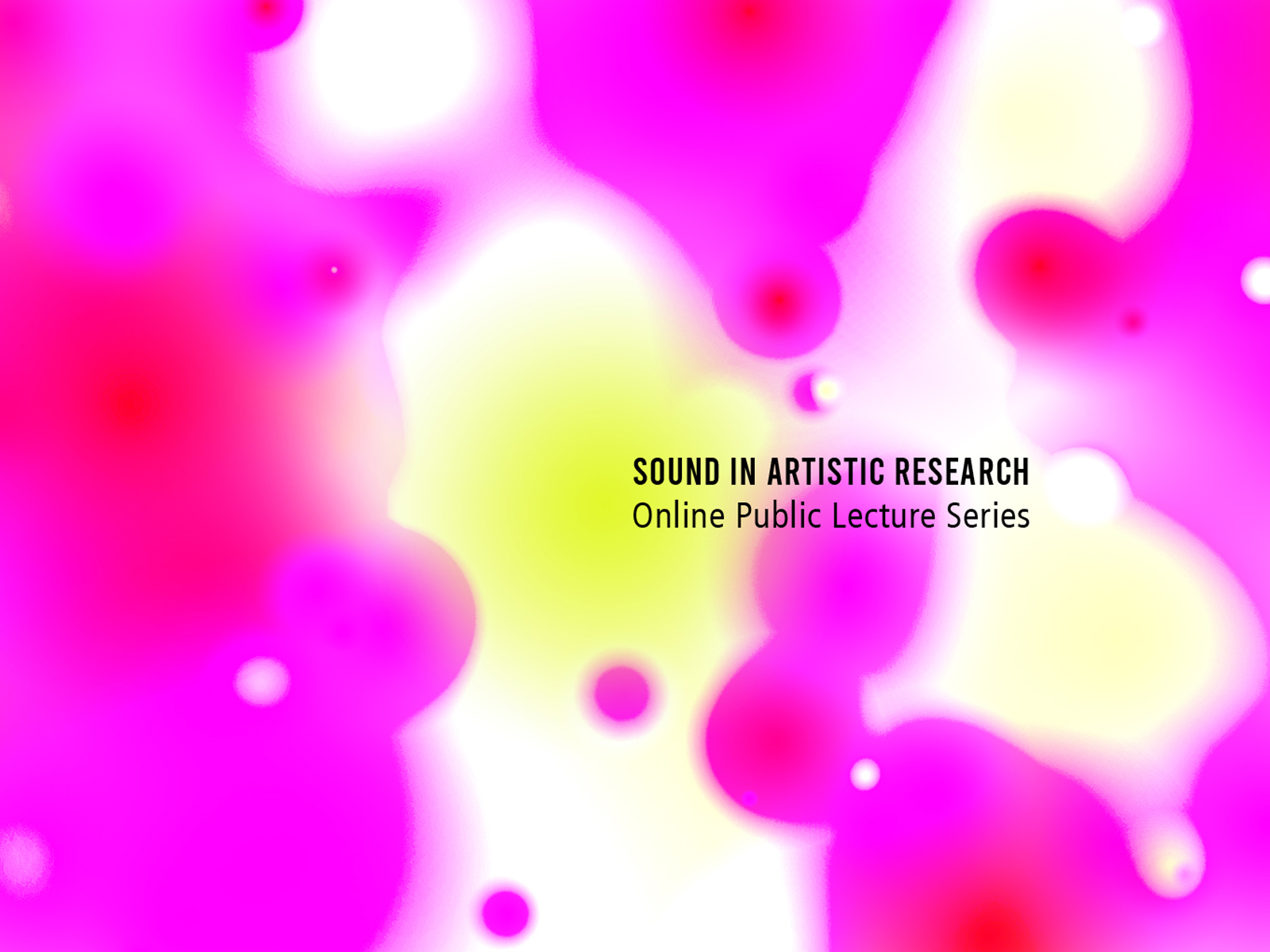
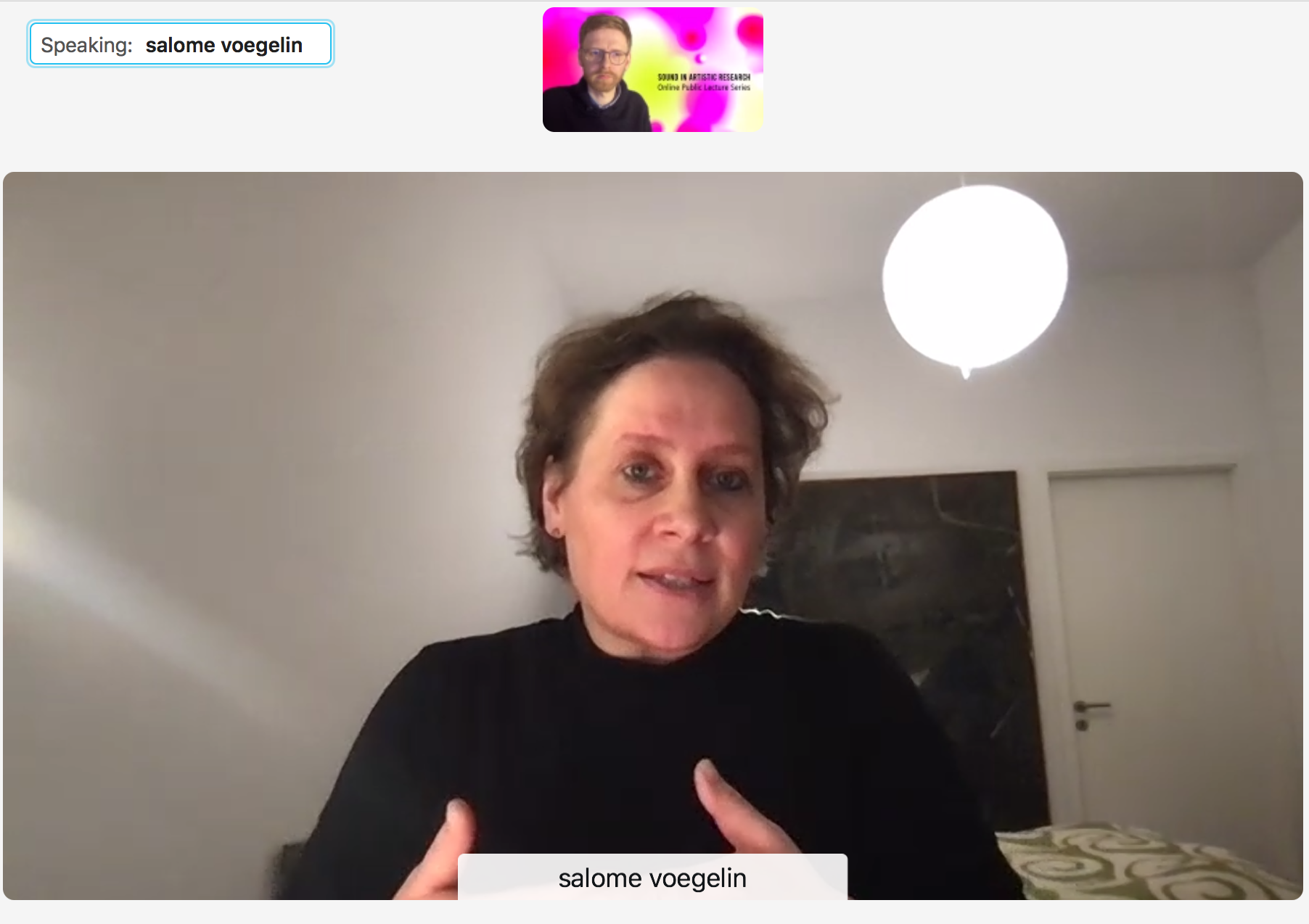
Photos © Kathrin Scheidt
3 Nov 2021 — 2 Feb 2022
Wednesdays | 6 — 8 p.m. (UTC +1) | online
In the winter semester 2021/22, Sound Studies and Sonic Arts presents a lecture series exploring sound in artistic research. The genome of the master program implies an understanding that theory and practice mutually inform each other and represent two sides of the same coin. We’d like to invite you to join this lecture series and explore the different perspectives on the topic of artistic research as an encouragement to reflect on your own positioning.
Artistic research, aesthetic research, and practice-based research have gained a lot of momentum at art schools and universities in the past few decades. Focusing on alternatives to established methodologies and paradigms based on evidence, historical and political analysis, musicology, critical thinking, and cultural studies, this lecture series addresses how artistic research has been established in sound studies and in the sonic arts.
Primarily for the current MA Sound Studies and Sonic Arts students at the UdK, these talks are also open to the general public and students from all other institutions and departments.
3 Nov 2021
Speaker : Jacob Eriksen + Sabine Sanio
Introduction to Sound in Artistic Research
This introductory lecture is divided into two parts. In the first part, we will focus on general positions in the theory of artistic research by asking the questions : How can we understand research as artistic ? What kind of outcome can artistic research produce ? Furthermore, how are these ideas addressed in political debates on artistic research in an academic context ? In the second part, we will focus on how evolutions in music and sound art can be understood through the lenses of artistic research. By examining different historical examples in music and sound art, we want to show how the notion of “the new” in compositional and artistic practice reacts to the composers and artists’ aesthetic and sociopolitical situatedness.

Photo © speakers
10 Nov 2021
Speaker : Salomé Voegelin
Sonic Possible and Impossible Bodies
Moderator : Jan Thoben
Stand in front of a mirror and repeat “why am I, I?” one hundred times.
This talk will consider the notion of sonic possible worlds in relation to the body. I will discuss the body as material and fleshly body, as human and more than human form, whose sonic possibilities ruptures norms and expectations through invisible permutations, silences and screams. Thus, I will sound and articulate a body in trans-formation, ephemeral and porous ; questioning of individuation and the boundary of the skin. And hope to hear the unrecognizable body, at the margins of the representational frame and at the brink of viability, to engage in how its sonic possibility challenges who we count as real, and how we hear their actuality : the norms and naturalizations that give us the recognizable body and its name.
Making connections between the work of, among others Hannah Silva, Jocy de Oliveira, Shilpa Gupta and Pamela Z, and the writings of Margrit Shildrick, Donna Haraway, Elizabeth Grosz and Rosi Braidotti, et al., we hear the promises of monsters, the dreams of cyborgs, the ambiguity of freaks, and reach the posthuman, and come to speculate on a vampiric invisibility that is the body’s material-self in its sonic shape, and in its being as being with every other thing, human and more than human in concatenation.
Not only did bodies indicate a world beyond themselves, but this movement beyond their own boundaries, a movement of boundary itself, appeared to be quite central to what bodies ‘are’.” (Judith Butler, Bodies That Matter, On the Discursive Limits of Sex, New York and London : Routledge, 1993, p. ix.)
Salomé Voegelin
Salomé Voegelin is an artist and writer engaged in listening as a socio-political practice. She writes essays, books and text-scores for performance and publication.
Most recently her book Sonic Possible Worlds 2014/21 appeared in a revised second edition, extending the discussion on the sonic possibility of the world to rethink normative constructions and fabulate a different body from its sound. Voegelin’s practice engages in participatory, collective and communal approaches and uncurates curatorial conventions through performance. She co-convenes, with Mark Peter Wright, the cross-disciplinary listening and sound making event Points of Listening https://pointsoflistening.net, and uncurates curatorial conventions to re-know the world from the connecting logic of sound.
Voegelin is a Professor of Sound at the London College of Communication, University of the Arts London, and currently represents the Professorship Klangkunst in den Kunstwissenschaften at the University of Art Braunschweig.
www.salomevoegelin.net @soundwords_sv
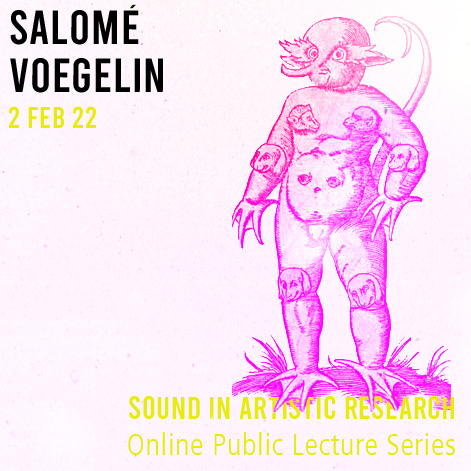
Photo © speakers
17 Nov 2021
Speaker : Chris Salter
Alien Agencies – Capturing Resonance from the Insider Perspective
Moderator : Daisuke Ishida
One of the key concepts in the notion of artistic research is the term research itself, which for all intents and purposes signifies the creation of new knowledge about some aspect of the world. Yet, research has some strong assumptions behind it – namely, that there is a distance to be established between the research object and the researcher themselves. This poses a rather complex problem for the artistic since the entire point of artistic practice is to intervene in the world, not to observe it at a critical distance. This gets even more complicated when it comes to the phenomena of sound – how to capture it as a research object at a distance when, in fact, with sound there is no distance and there is no object. This talk bases itself on a chapter from my 2015 MIT Press book Alien Agency : Experimental Encounters with Art in the Making which focuses on the work of sound artists O+A (Bruce Odland and former Sound Studies Guest Professor, Sam Auinger). The book asks what happens in creative practice when the materials of art and research behave and perform in ways beyond a creators’ intentions. To make the problem stickier and more intriguing, how does an artist themself (in this case, the author Chris Salter) understand the practices of other artists at both a distance and close up in order to investigate how new sonic events can come into the world and how they shape both knowing and experiencing that world in a new way.
Chris Salter
Chris Salter is an artist, Professor for Design + Computation Arts at Concordia University in Montréal and Co-Director of the Hexagram network. He studied philosophy, economics, theatre and computer music at Emory and Stanford Universities. His artistic work has been seen all over the world at such venues as the Venice Architecture Biennale, Barbican Centre, Berliner Festspiele, Wiener Festwochen, ZKM, Musée d’art Contemporain, EXIT Festival and Place des Arts-Montréal, among many others. He is the author of Entangled : Technology and the Transformation of Performance (MIT Press, 2010) and Alien Agency : Experimental Encounters with Art in the Making (MIT Press 2015). His new book Sensing Machines will be published by MIT Press in 2022.
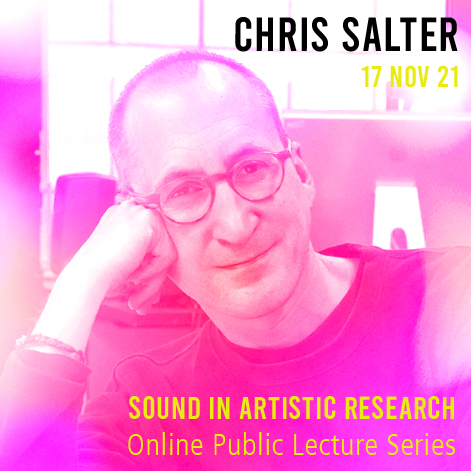
Photo © speaker
24 Nov 2021
Speaker : Dieter Mersch
Sounds of Silence. On compositional research
Moderator : Bernhard Rietbrock
The musical production of the post-war period often saw itself as as “experimental”. The fuzzy term can be specified, if understood from the point of view of a genuine research practice. This equally concerns noises, tones, sounds, and silences, their relation to space and time as well as to the listeners and their specific “work of hearing”, the “howling” (Ginsberg) of real events in the world and their recording or archiving by mass media, which carry their noise into the last corners of private existence. Sound as Research was pursued in a particularly radical way in the succession of John Cage by the Fluxus artists, who based their aesthetic practice primarily on the emptiness and fullness of musical performance. The lecture will deal with some famous examples, in order to not only explore the limits and possibilities of the concept of research in the arts, but also to sharpen its definition.
Dieter Mersch
Dieter Mersch, Prof. em. for Aesthetic Theory at the Zurich University of the Arts and former director of its Institute for Theory, also was the president of the German Society for Aesthetics until this year. Most important publications : Was sich zeigt. Materialität, Präsenz, Ereignis (2002); Ereignis und Aura. Untersuchungen zu einer Ästhetik des Performativen (2002); Medientheorien zur Einführung (2006); Posthermeneutik (2010); and Epistemologien des Ästhetischen (2015).

Photo © speaker
1 Dec 2021
Speaker : Alfred Darlington
Composing for surround sound installation and performance
Moderator : Jan Thoben
Examining listening modalities in immersive environments with special consideration given to time scale and gesture. Also how we might utilize Ambisonics and/or Wave field Synthesis (WFS) as bridge to Oliveros-ian Deep Listening. No need for specialized equipment as we will be focused on abstraction best suited for future proofing. Following this discussion Daedelus will share initial results from their time as artist in residence at S.E.T.I. building (un)Earthed — a multifaceted experience extending the audience’s ear upward as antenna.
Alfred Darlington
Daedelus (Alfred Darlington) is a prolific producer and performer. Renowned as an early user of Monome grid controllers, they are founding faculty of Berklee College of Music’s EDI (Electronic Digital Instrument) principle instrument program, and A.I.R. with S.E.T.I.

Photo © speaker
8 Dec 2021
Speaker : The Neighbourhood Character / Ari Robey-Lawrence
Building Intersectional Community via Interdisciplinary Research and Creative Praxis
Moderator : Daisuke Ishida
This talk will draw on examples from the artist’s own collaborative practice to explore the potential of interdisciplinary research and practice-led methodologies as applied to electronic music in creative industries contexts, and how to facilitate artistic interaction, engagement, empowerment exchange through such means.
Ari Robey-Lawrence
The Neighbourhood Character / Ari Robey-Lawrence, (she/they) is an electronic music producer / composer, vocalist, DJ, educator & researcher, and creative industries freelancer.
They are a co-curator of DICE Conference & Festival, and the founder of wood // work collective, an intersectional platform communicating through diverse forms of creative expression conceived with the purpose to create alternative avenues for socio-cultural mobility, professional self-empowerment, and transnational interchange in creative industries.
Ari’s doctoral research (Goldsmiths Media and Comms) traces interventions in the politics and praxes of reciprocal and self- empowerment by Black electronic and dance music producers. As a public speaker, they engage with issues of race, politics and community through the lens of the dance music, and over the last three years has curated and organised a range of panel events and workshops, with topics ranging from strategies for mental health & preservation, legacies of DIY resistance, identity politics, and intergenerationality in the dance music scene featuring a range of Berlin & EU- based qtibpoc artists, cultural and community workers.
From 2014 — 2021, Ari was a core curatorial member in one of Berlin’s few remaining intersectional & non-profit DIY spaces ; Raumerweiterungshalle, and co- organised and facilitated a range of events aimed towards promoting the engagement of Black and intersectional artists over the years ; most recently including a 3- day vinyl DJ workshop as part of the 2018–19 SWITCH Music Workshops, which provided free and accessible electronic music education to intersectional qtibpoc in Berlin.
As The Neighbourhood Character, Ari has released a number of collaborative and solo projects both digitally and on vinyl, played at a range of local and EU nightlife events and venues since 2015, hosted radio programming on Berlin Community Radio, THF Radio, with appearances on NTS, Radio80k, Nightshade FM and more. They have designed sound for a wide array of productions for independent artists and directors, and collaborated with established companies such as the Maxim-Gorki Theatre. Most recently they have worked behind the scenes as part of the staff at Berlin’s Hard Wax, and currently leads an undergraduate module on Creative Collaboration as a Lead Lecturer at BIMM Institute Berlin.

Photo © speaker
15 Dec 2021
Speaker : Alex Arteaga
Aesthetic Aural Research
Moderator : Sabine Sanio
This lecture addresses two successive specifications of the concept of artistic research. The first consists in understanding this kind of research as a variety of inquiry realized through aesthetic practices beyond the normativity of the art system. “Aesthetics” here will be outlined in the framework of the enactive approach to cognition basically as a kind of transformative interaction. The second specification proposes a realization of aesthetic research in the aural sphere through the performance of practices of hearing and listening.
Dr. Alex Arteaga
Alex Arteaga is an artist researcher who combines and hybridizes aesthetic, phenomenological and enactivist research practices through an inquiry into embodiments, environments and aesthetic cognition. He studied music theory, piano, electronic music, composition and architecture in Barcelona and Berlin and received a PhD in philosophy at the Humboldt University Berlin for his dissertation Sensuous Framing : Fundamentals of a Strategy to Realize Conditions of Perception. He was post-doc research fellow at the Collegium for the Advanced Study of Picture Act and Embodiment (Humboldt University Berlin) and one of the principal investigators in the research project Visual and Auditory Perceptual Apparatus for the Evaluation of City Development in Agglomerations (Zurich University of the Arts). He has been visiting professor in different universities such as the University of the Arts Helsinki and the Berlin University of the Arts, curator of the Research Venter at a.pass (Brussels), senior researcher at KASK School of Art HOGENT in the framework of the research project Distraction as Discipline and member of the editorial board of the Journal for Artistic Research. Alex Arteaga develops long-term artistic research projects such as Architecture of Embodiment (www.architecture-embodiment. org) or Contingent Agencies (www.contingentagencies.net).

Photo © speaker
12 Jan 2022
Speaker : Ania Mauruschat
The Symphony of Sirens by Avraamov/Ammer/Einheit as Artistic Research on the Political Dimension of Noise
Moderator : Sabine Sanio
In October 2017, the German radio play artists Andreas Ammer and FM Einheit restaged Arsenij Avraamovs Symphony of Sirens, which is considered to be the loudest composition in music history and has only been presented to the public two times : 1922 in Baku and 1923 in Moscow as celebrations of the Bolshie revolution. 100 years after October 1917 Ammer and Einheit were invited by the Philharmonics Brno in Czech Republic to stage it again due to the centenary of the revolution. Instead of a sheer reenactment Ammer and Einheit came up with their own interpretation of Avraamov’s Symphony of Sirens, which can be regarded as the result of their individual and collective artistic research of more than 30 year on the legacies of the avant-gardes, on developments of acoustic technology and on Walter Benjamin’s philosophy of history. The talk will explicate this claim by referring to acoustic and visual examples.
Ania Mauruschat
Ania Mauruschat is a German media studies scholar (aesthetics & ecology, theory & culture) and lecturer, focussing on sound and radio. She was trained as a radio journalist and as an editor and educated in the humanities and social sciences in Munich. From 2002 to 2012 she worked full-time for the press and public radio stations, mainly focussing on the ramifications of digitization on art, literature and sciences. From 2012 to 2014 she worked as a scientific assistant, lecturer and project manager at the chair for media aesthetics at the University of Basel, Switzerland. From 2018 to 2021 she was member of the PhD lab “Epistemologies of Artistic Practices”, working on the epistemology of radio art. Since September she is Marie Curie Research Fellow of the European Commission at the University of Copenhagen, Denmark. The title of her postdoc project is “Sounding Crisis” (www.soundingcrisis.eu).
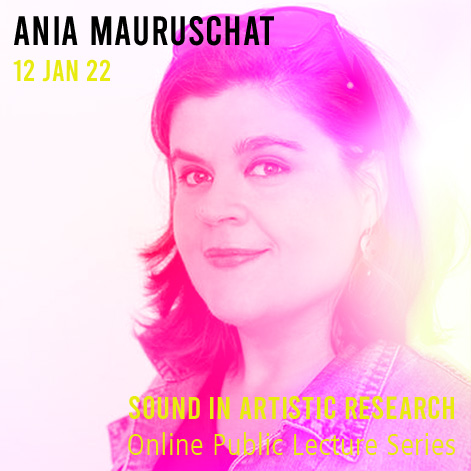
Photo © speaker
19 Jan 2022
Speaker : Budhaditya Chattopadhyay
Connecting Resonances : A Decolonial Intervention into Artistic Research in/through Sound and Listening
Moderator : Jacob Eriksen
The talk intends to create a fertile entry point into the history, practices and aesthetics of sound and listening in South Asia as a key area of the Global South. The talk facilitates an understanding of the unique auditory culture and sonic sensibility of the underexplored southern part of the globe by an artistic research approach departing from the speaker’s own practice with sound and listening. Such new knowledge fundamentally shifts the perspectives in sound studies and in a global sonic art history with a decolonial approach of co-listening with the marginal and nomadic voices in a mode of reciprocity. The talk re-examines a fundamental issue in the studies of modernity and globalization concerned with media cultural encounters and technological transmissions between Global North and South as a two-way process of postcolonial confluence. The project draws from the body of work of practitioners active in South Asia, whose work has often been neglected in the Eurocentric field of sound studies and sonic arts.
Budhaditya Chattopadhyay
Budhaditya Chattopadhyay is an artist, media practitioner, researcher, and writer. Incorporating diverse media, creative technologies and research, Chattopadhyay produces works for large-scale installation and live performance addressing contemporary issues of environment and ecology, migration, race and decoloniality. Chattopadhyay has received numerous residencies, fellowships, and international awards. His sound works have been widely exhibited, performed or presented across the globe, and released by Gruenrekorder (DE) and Touch (UK). Chattopadhyay has an expansive body of scholarly publications in the areas of media art history, theory and aesthetics, cinema and sound studies in leading peer-reviewed journals. He is the author of three books, The Nomadic Listener (2020), The Auditory Setting (2021), and Between the Headphones (2021). Chattopadhyay holds a PhD in Artistic Research and Sound Studies from the Academy of Creative and Performing Arts, Leiden University, and an MA in New Media from the Faculty of Arts, Aarhus University.

Photo © Janno Bergmann For Copper Leg
26 Jan 2022
Speaker : Jenny Gräf Sheppard
Sonic Orientations Ambisonics Research
Moderator : Jacob Eriksen
In this talk I will present the framework for research that takes place within the research project, Sonic Orientations, as a means to describe how sound and sonic methodologies function as articulations. I use the terms sounding to refer to a range of specific sonic methodologies that work to collapse (or perhaps question) distinctions of sounder/listener, subject/object, audience/artist, while also serving to emphasize in the present participle the movement, time, change and action of practice. In sharing the theoretical framework of the project along with audio-visual documentation, I aim to share the ways in which we are sounding research. The project comprises one part of my PhD titled Communicating Vessels : redefining agency through sounding.
Sonic Orientations, funded by the Danish Ministry of Culture, establishes a facility and research group around Ambisonics (3D sound) and its potential in Media Art to open up new perspectives on subjectivity and narrative through spatialized sound. Sonic Orientations research is framed by the question : What are some of the methods and techniques that can be used within Ambisonic immersive sound to experiment with shifting subjectivity, orientations and new narrative forms ? The project initiates an international dialogue around this particular sound technology and its potential in VR and Media Art formats to re-orient the listening subject. A research group works to develop approaches to Ambisonics chamber as not simply a tool, but as a creative instrument for working with fluid subjectivities and experimental narrative approaches. With theoretical texts that inform our creative experiments, we are pushing the potential of this very under-studied form of 3D sound. By exploring this immersive sound technology and associated practice from a theoretical perspective, the aim is to connect various theoretical ideas with the experiential potential of spatialized sound, offering new perspectives on subjectivity, agency and narrative.
Jenny Gräf Sheppard
Jenny Gräf Sheppard is a musician, artist and sound researcher based in Copenhagen. In her work, she activates peripheral places and states through sound composition, improvisation and participatory works. She works with immersion and rupture to explore changing perceptions of diegesis and space, formal choices rooted in a deep interest in social behaviors and perceptual fields. Her works range from sound collaborations with older women with dementia, to tactile speaker design, and collaborative research within an Ambisonic chamber.
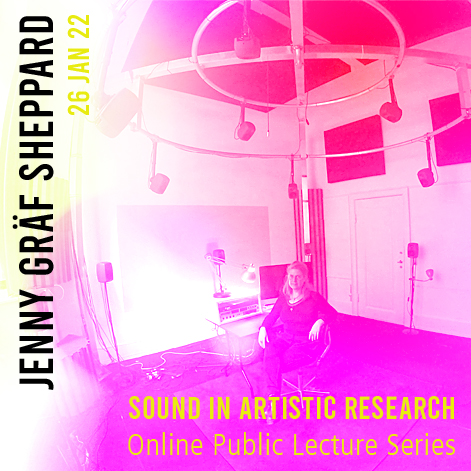
Photo © speaker
2 Feb 2022
Speaker : Åsa Stjerna
Sonic Documentarism?- An Ecosophical Perspective
Moderator : Julia H. Schröder
In the era referred to as the Anthropocene, Sonic arts play an important role in problematizing and making experienceable the global condition. Sonic practices such as field recordings and forms of sonification, at the same time constitute practices of witnessing, making audible usually inaudible data, and making connections between the local and the global.
But what happens to the “documentary” when scientific statements are transformed into an artistic context ? And conversely, what happens to the “artistic” in the engagement with scientific data ? In this presentation, Åsa Stjerna discusses the possibilities and dilemmas of sonic practice as documentary practice, drawing on her own artistic practice and artistic research.
Åsa Stjerna
Åsa Stjerna is a Swedish artist using sound and listening as her artistic modes of exploration. Through her site-specific installations, she explores sound’s potential, making the embedded conditions and underlying narratives connected to a situation perceivable, drawing connections between past and present, local and global, as well as human and more-than human. By this she seeks to reframe the act of listening, evoking a sensibility of places as complex ecologies.
Also active as artistic researcher, she has been specifically interested in exploring the contemporary conditions of sonic situated practice and its ability of being transformative, i.e. what it actually means “to make a difference” in the era of Antrophocene and advanced capitalism. Guided by methodologies of feminism, ecosophy and posthumanism she proposes an understanding of site-specificity as an aesthetic–ethical practice and engagement between specific and diverse “bodies” with agencies—human as well as non-human, spanning across and connecting the material, social, discursive, artistic, and technical realms at the same time in a given situation.
Stjerna has participated in an extensive number of exhibitions internationally, among other Klangstaetten Stadtklänge Braunschweig, the Transmediale Media Festival, Berlin ; the Nordic Music Days, Stockholm ; the Ultima Contemporary Music festival, Oslo and the Akademie der Künste, Berlin. Her works include several public permanents commissions : Earth Song (2020), commissioned by Stockholm Konst ; Sky Brought Down (2017) Sahlgrenska university hospital in Gothenburg, Sweden commissioned by Västra Götalandsregionens konstenhet and The Well (2014) at Swedish Institute in Paris commissioned by the Public Art Agency Sweden.
Stjerna represents professorship sound art at Hochschule für bildende Künste in Braunschweig, Germany, 2020–2021.

Photo © speaker
